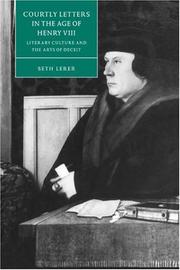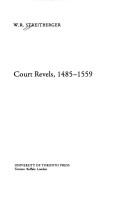| Listing 1 - 9 of 9 |
Sort by
|
Book
ISBN: 3465141857 9783465141853 9783465041856 3465041852 Year: 2013 Publisher: Frankfurt am Main Vittorio Klostermann
Abstract | Keywords | Export | Availability | Bookmark
 Loading...
Loading...Choose an application
- Reference Manager
- EndNote
- RefWorks (Direct export to RefWorks)
Wenn frühneuzeitliche Höfe, wie von Zeitgenossen immer wieder behauptet, nach Art einer Bühne funktionieren, dann liegt es nahe, höfisches Leben nach Praktiken des Sehens und Gesehen-Werdens, der Beobachtung, der Überwachung, des Zuschauens zu befragen. Während das höfische lch durch Prozesse formierenden Sehens entsteht, kann auch der Hof selbst, als Ort der Macht, als Produkt des koniglichen Blicks beschrieben werden. Der Band widmet sich den visuellen Praktiken an frühneuzeitlichen Höfen und untersucht die Formen und Funktionen sowie die Produktivität des Zuschauerblicks am elisabethanische
Spectators --- Persons --- Audiences --- History --- Elizabeth --- Elisabeth --- Relations with courts and courtiers. --- Great Britain --- Court and courtiers
Book
Year: 2011 Publisher: [Place of publication not identified] : Perlego,
Abstract | Keywords | Export | Availability | Bookmark
 Loading...
Loading...Choose an application
- Reference Manager
- EndNote
- RefWorks (Direct export to RefWorks)
George --- Relations with courts and courtiers. --- Great Britain --- History --- Court and courtiers
Book
Year: 2011 Publisher: [Place of publication not identified] : Perlego,
Abstract | Keywords | Export | Availability | Bookmark
 Loading...
Loading...Choose an application
- Reference Manager
- EndNote
- RefWorks (Direct export to RefWorks)
George --- Relations with courts and courtiers. --- Great Britain --- Court and courtiers --- History
Book
Year: 2007 Publisher: Project Gutenberg
Abstract | Keywords | Export | Availability | Bookmark
 Loading...
Loading...Choose an application
- Reference Manager
- EndNote
- RefWorks (Direct export to RefWorks)
Elizabeth I --- Queen of England --- 1533-1603 --- Relations with courts and courtiers --- Great Britain --- History --- Elizabeth --- 1558-1603
Book
Year: 2010 Publisher: Project Gutenberg
Abstract | Keywords | Export | Availability | Bookmark
 Loading...
Loading...Choose an application
- Reference Manager
- EndNote
- RefWorks (Direct export to RefWorks)
Henry VIII --- King of England --- 1491-1547 --- Relations with courts and courtiers --- Shakespeare --- William --- 1564-1616. King Henry VIII --- Great Britain --- History --- 1509-1547
Book
ISBN: 1496214552 1496214536 9781496214553 9781496214539 9781496207593 1496207599 9781496214546 Year: 2019 Publisher: Lincoln, Nebraska
Abstract | Keywords | Export | Availability | Bookmark
 Loading...
Loading...Choose an application
- Reference Manager
- EndNote
- RefWorks (Direct export to RefWorks)
"Age in Love contributes to the ongoing debate about the emergence of a Tudor public sphere, building on the current interest in premodern constructions of aging and ultimately demonstrating that the Elizabethan court shaped Shakespeare's plays in unexpected and previously undocumented ways"--
Courts and courtiers in literature. --- Older men in literature. --- English literature --- Aged men in literature --- History and criticism. --- Elizabeth --- Shakespeare, William, --- Relations with courts and courtiers. --- Characters --- Queens. --- Political and social views. --- Great Britain --- Court and courtiers --- History
Book
ISBN: 1487518463 9781487518462 9781487518479 1487518471 9781487503666 1487503660 Year: 2019 Publisher: Toronto, Ont. University of Toronto Press
Abstract | Keywords | Export | Availability | Bookmark
 Loading...
Loading...Choose an application
- Reference Manager
- EndNote
- RefWorks (Direct export to RefWorks)
"Under glittering lights in the Louvre palace, the French court ballets danced by Queen Marie de Medicis prior to Henri IV's assassination in 1610 attracted thousands of spectators ranging from pickpockets to ambassadors from across Europe. Drawing on newly discovered primary sources as well as theories and methodologies derived from literary studies, political history, musicology, dance studies, and women's and gender studies, Dancing Queen traces how Marie's ballets authorized her incipient political authority through innovative verbal and visual imagery, avant-garde musical developments, and ceremonial arrangements of objects and bodies in space. Making use of women's "semi-official" status as political agents, Marie's ballets also manipulated the subtle social and cultural codes of international courtly society in order to more deftly navigate rivalries and alliances both at home and abroad. At times the queen's productions could challenge Henri IV's immediate interests, contesting the influence enjoyed by his mistresses or giving space to implied critiques of official foreign policy, for example. Such defenses of Marie's own position, though, took shape as part of a larger governmental program designed to promote the French consort queen's political authority not in its own right but as a means of maintaining power for the new Bourbon monarchy in the event of Henri IV's untimely death."--
Ballet --- Dance --- Pantomime --- History --- France --- Court and courtiers --- Bourbon monarchy. --- France. --- French court ballets. --- French. --- Henri IV. --- Louvre. --- Queen Marie de Médicis. --- dance studies. --- literary studies. --- musicology. --- political history. --- women’s and gender studies. --- Music --- Theatrical science --- Medici, de', Maria [Queen of France] --- Marie de Medicis, --- Knowledge --- Ballet. --- Relations with courts and courtiers. --- Marie de Médicis, --- Médicis, Marie de, --- De Médicis, Marie, --- Maria de' Medici, --- De' Medici, Maria, --- Medici, Maria de', --- 1589-1699

ISBN: 9780511582004 9780521590013 9780521035279 0585030103 9780585030104 0521590019 0521590019 0511582005 0511000820 9780511000829 0521035279 Year: 1997 Volume: 18 Publisher: New York, NY, USA Cambridge University Press
Abstract | Keywords | Export | Availability | Bookmark
 Loading...
Loading...Choose an application
- Reference Manager
- EndNote
- RefWorks (Direct export to RefWorks)
This revisionary study of the origins of courtly poetry reveals the culture of spectatorship and voyeurism that shaped early Tudor English literary life. Through research into the reception of Chaucer's Troilus and Criseyde, it demonstrates how Pandarus became the model of the early modern courtier. His blend of counsel, secrecy and eroticism informed the behaviour of poets, lovers, diplomats and even Henry VIII himself. In close readings of the poetry of Hawes and Skelton, the drama of the court, the letters of Henry VIII to Anne Boleyn, the writings of Thomas Wyatt, and manuscript anthologies and early printed books, Seth Lerer illuminates a 'Pandaric' world of displayed bodies, surreptitious letters and transgressive performances. In the process, he redraws the boundaries between the medieval and the Renaissance and illustrates the centrality of the verse epistle to the construction of subjectivity.
English literature --- Politics and literature --- Civilization, Medieval, in literature. --- Courts and courtiers in literature. --- Deception in literature. --- Renaissance --- History and criticism. --- History --- Henry --- Chaucer, Geoffrey, --- Chaucer, Jeffrey, --- Chʻiao-sou, Chieh-fu-lei, --- Chieh-fu-lei Chʻiao-sou, --- Choser, Dzheffri, --- Choser, Zheoffreĭ, --- Cosvr, Jvoffrvi, --- Tishūsar, Zhiyūfrī, --- Henricus --- Heinrich --- Enrique --- Henri --- Hendrik --- Enrico --- Relations with courts and courtiers. --- Influence. --- Great Britain --- Historiography. --- Court and courtiers --- Arts and Humanities --- Literature

ISBN: 1282003038 9786612003035 1442673559 080200590X 1442614862 9781442673557 9781282003033 9780802005908 Year: 1994 Volume: 3 Publisher: Toronto, Ont. University of Toronto Press
Abstract | Keywords | Export | Availability | Bookmark
 Loading...
Loading...Choose an application
- Reference Manager
- EndNote
- RefWorks (Direct export to RefWorks)
In 1545 Henry VIII created a Revels Office within the royal household and appointed Sir Thomas Cawarden, one of the gentlemen of the Privy Chamber, as its Master. In so doing he set a precedent for the production of revels at court for the next century. Some historians have only recently examined the revels in their historical context, but none has attempter, as W.R. Streitberger does, to study court entertainments in terms of the growth and development of the Revels organization and its adaptation to different political climates at court. Streitberger presents evidence in the form of a calendar of court entertainments and appendices based on the primary documents; he provides an explanation of their occasion, form, and purpose of these entertainments in their historical context; and he explains the development of the revels organization from the temporary appointment of producers at the beginning of their period into a government office by the mid-sixteenth century. Streitberger details the adaptation of the Revels organization to the very different courts of the various monarchs, and explains how their personalities, principles, and policies shaped that adaptation.
Pageants --- Amusements --- Performing arts --- History --- Production and direction --- Chronology. --- Great Britain --- Court and courtiers --- Production and direction. --- English literature --- Direction (Performing arts) --- Production (Performing arts) --- Direction --- Amateur plays --- Festivals --- Processions --- Show business --- Arts --- Performance art --- Children --- Entertainments --- Pastimes --- Recreations --- Entertaining --- Games --- Play --- Recreation --- English drama --- Early modern and Elizabethan, 1500-1600 --- History and criticism --- Masks --- Theater --- England --- 16th century --- Theater and state --- 19th century --- English drama - Early modern and Elizabethan, 1500-1600 - History and criticism. --- Masques - History and criticism. --- Theater and state - England - History - 16th century. --- Great Britain - Court and courtiers. --- Great Britain - History - Henry VIII, 1509-1547. --- Henry --- Relations with courts and courtiers. --- Great Britain. --- Henricus --- Heinrich --- Enrique --- Henri --- Hendrik --- Enrico --- England and Wales.
| Listing 1 - 9 of 9 |
Sort by
|

 Search
Search Feedback
Feedback About UniCat
About UniCat  Help
Help News
News